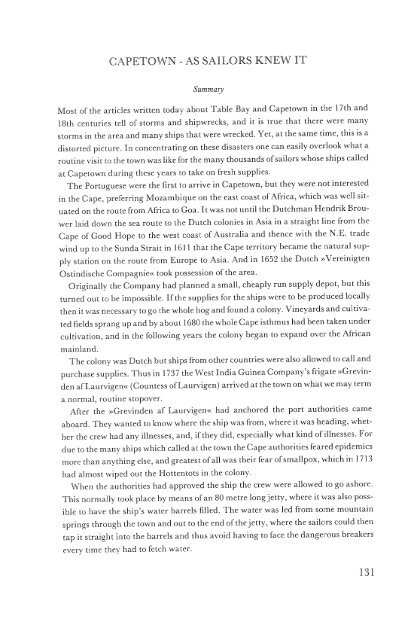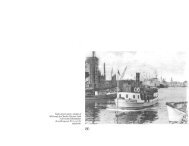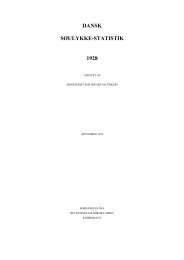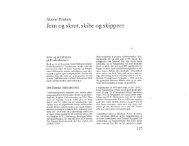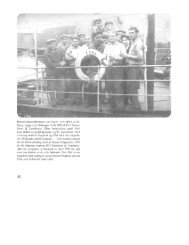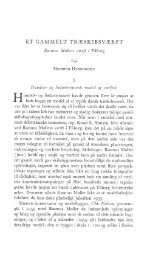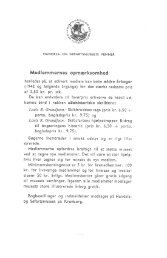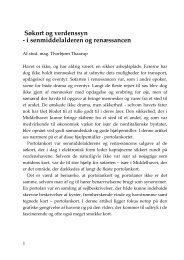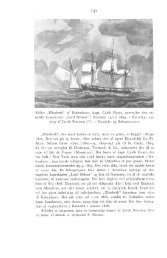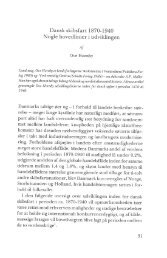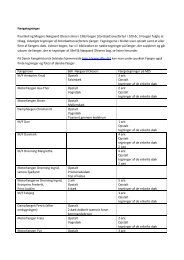Kapstaden, som de kendte den, s. 100-132 - Handels- og ...
Kapstaden, som de kendte den, s. 100-132 - Handels- og ...
Kapstaden, som de kendte den, s. 100-132 - Handels- og ...
You also want an ePaper? Increase the reach of your titles
YUMPU automatically turns print PDFs into web optimized ePapers that Google loves.
CAPETOWN - AS SAILORS KNEW IT<br />
Summary<br />
Most ofthe articles written today about Table Bay and Capetown in the 17th and<br />
18th centuries tell of storms and shipwrecks, and it is true that there were many<br />
storms in the area and many ships that were wrecked. Yet, at the same time, this is a<br />
distorted picture. In concentrating on these disasters one can easily overlook what a<br />
routine visit to the town was like for the many thousands of sailors whose ships called<br />
at Capetown during these years to take on fresh supplies.<br />
The Portuguese were the first to arrive in Capetown, but they were not interested<br />
in the Cape, preferring Mozambique on the east coast of Africa, which was well sit<br />
uated on the route from Africa to Goa. It was not until the Dutchman Hendrik Brou<br />
wer laid down the sea route to the Dutch colonies in Asia in a straight line from the<br />
Cape ofGood Hope to the west coast of Australia and thence with the N.E. tra<strong>de</strong><br />
wind up to the Sunda Strait in 1611 that the Cape territory became the natural sup<br />
ply station on the route from Europe to Asia. And in 1652 the Dutch »Vereinigten<br />
Ostindische Compagnie« took possession ofthe area.<br />
Originally the Company had planned a small, cheaply run supply <strong>de</strong>pot, but this<br />
turned out to be impossible. If the supplies for the ships were to be produced locally<br />
then it was necessary to go the whole h<strong>og</strong> and found a colony. Vineyards and cultiva-<br />
ted fieids sprang up and by about 1680 the whole Cape isthmus had been taken un<strong>de</strong>r<br />
cultivation, and in the following years the colony began to expand over the African<br />
mainland.<br />
The colony was Dutch but ships from other countries were also allowed to call and<br />
purchase supplies. Thus in 1737 the West India Guinea Company's frigate »Grevin<br />
<strong>de</strong>n af Laurvigen« (Countess of Laurvigen) arrived at the town on what we may term<br />
a normal, routine stopover.<br />
After the »Grevin<strong>de</strong>n af Laurvigen« had anchored the port authorities came<br />
aboard. They wanted to know where the ship was from, where it was heading, whet<br />
her the crew had any illnesses, and, if they did, especially what kind of illnesses. For<br />
due to the many ships which called at the town the Cape authorities feared epi<strong>de</strong>mics<br />
more than anything else, and greatest ofall was their fear of srnallpox, which in 1713<br />
had almost wiped out the Hottentots in the colony.<br />
When the authorities had approved the ship the crew were allowed to go ashore.<br />
This normally took place by means ofan 80 metre long jetty, where it was also poss<br />
ible to have the ship's water barreis filled. The water was led from <strong>som</strong>e mountain<br />
springs through the town and out to the end ofthe jetty, where the sailors could then<br />
tap it straight into the barreis and thus avoid having to face the dangerous breakers<br />
every time they had to fetch water.<br />
131


